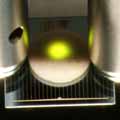Highlights from Photonics West articles

Frequency-doubled photonic crystal nanocavity lasers
Photonic crystal nanocavity lasers with quantum dot gain directly generate coherent visible light via nanocavity-enhanced nonlinear optical frequency doubling.

Optofluidic microlasers based on liquid droplet resonators for biophotonics
Liquid droplets are flexible and easy to produce, making them attractive as tunable light sources for a range of biologically relevant applications.

Single-crystal fibers for higher-power lasers
Single-crystal fibers of yttrium aluminum garnet could enable lasers with approximately 50 times more output power than those using conventional doped silica fibers.

Using the full solar spectrum with upconverter devices
Attaching a device to photovoltaic cells that converts the unused and transmitted sub-band-gap photons to usable photons significantly enhances solar cell efficiency.

New quantum dot nanomaterials to boost solar energy harvesting
Sequential photon absorption processes in semiconductor solar cells represent a route to improving their efficiency.
 Terahertz multiplex imaging with reconfigurable masks
Terahertz multiplex imaging with reconfigurable masks
Terahertz spatial light modulators composed of metamaterial arrays enable novel imaging techniques, offering the potential for improved image resolution, acquisition time, and spectral information.
 Three-dimensional dancing bear shows the way to practical holographic display
Three-dimensional dancing bear shows the way to practical holographic display
A dynamic holographic display of full-color, full-parallax 3D objects was demonstrated using physical and optical scan tiling techniques, enhanced by a newly proposed color mixing method.
 Plasmonic and dielectric enhancement of solar cells
Plasmonic and dielectric enhancement of solar cells
Experimental, computational, and analytic advances in nanophotonic light trapping promise the next generation of high-efficiency, low-cost photovoltaics.
 Compressive sensing for imaging spatial entanglement
Compressive sensing for imaging spatial entanglement
Compressive sensing provides a practical method for characterizing correlations between pairs of spatially entangled photons at high dimensions.
 A spherical color model is intuitively simple and perceptually harmonious
A spherical color model is intuitively simple and perceptually harmonious
The three coordinate components of a properly rotated spherical coordinate system perfectly describe the perceptual attributes of a color.
 Progress in hybrid-silicon photonic integrated circuit technology
Progress in hybrid-silicon photonic integrated circuit technology
Adding III-V materials to the silicon-on-insulator platform enables increasingly complex devices, making it well-positioned to address energy-efficient, compact, and low-cost photonic applications.
 Proton-implantation technique for high-power laser light
Proton-implantation technique for high-power laser light
An arrayed configuration with proton-implanted current apertures creates the potential for more reliable, higher-powered vertical-cavity surface-emitting lasers.
Photonics West 2013 Program